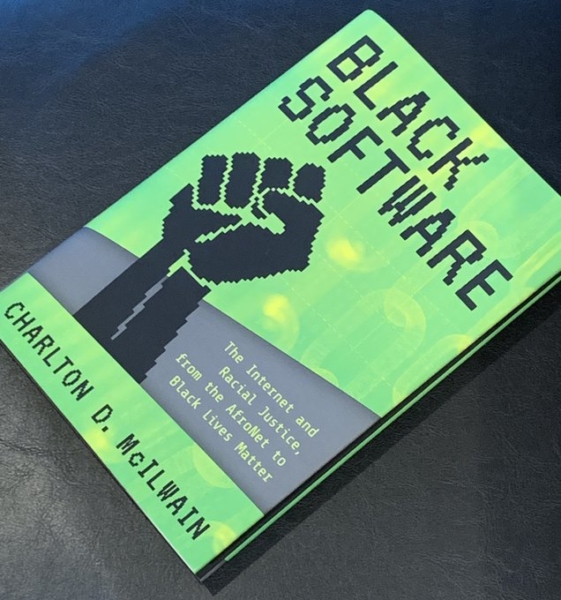In Black Software: The Internet & Racial Justice, From the Afronet to Black Lives Matter, New York University professor Charlton McIlwain asks in his introduction a question that seems even more pressing in our time since the extraordinary events at the U.S. Capitol on January 6 about the role of technology and government in addressing issues of racial justice in America. He asks …

Black Software by Charlton D. McIlwain
“ … a most significant question, not about recently popularized concepts like computer bias, or fair algorithms, or platform inequality, or digital ethics. No, the question goes to the heart of the matter that these concepts merely skirt around: will our current or future technological tools ever enable us to outrun white supremacy? After all, this is not just our country’s founding principle. It is also the core programming that preceded and animated the birth, development, and first use of our computational systems.
McIlwain is Vice Provost for Faculty Engagement & Development, and Professor of Media, Culture, and Communication at New York University. His research focuses on the intersections of race, digital media, and racial justice activism. His recent publications include “Racial Formation, Inequality & the Political Economy of Web Traffic,” in the journal Information, Communication & Society, and the recent co-authored report “Beyond the Hashtags: Ferguson, #BlackLivesMatter, and the Online Struggle for Offline Justice.” He is also the founder of the Center for Critical Race & Digital Studies. McIlwain wants us to see and hear something more important in our ostensibly apolitical language of tech.
Black Software charts the simultaneous rise of civil rights and computer revolutions in the 1960s, and the long, often erased, relationship between African Americans, computing technology, and the Internet. He writes about the forgotten figures who worked to make black politics central to the internet’s birth and evolution and paved the way for today’s explosion of racial justice activism. He describes in detail how computing technology has been used to neutralize the threat that black people pose to the existing racial order, but also how black people seized these new computing tools to build community, wealth, and wage a war for racial justice.

Getty/Misha
McIlwain’s work highlights the critical, but often invisible role federal investment in technology and the federal contractors building the technology of government play in either maintaining or changing our racial politics.
Last year the Center for American Progress made an explicit case for identifying the “hidden figures” in the current landscape of federal technology policy. In Redesigning Federal Funding of Research and Development: The Importance of Including Black Innovators, they note: “Federal R&D spending has often yielded great returns on investment, seeding successes such as the internet, the Google search engine, the MRI, and the Human Genome Project—ubiquitous advances that play critical roles in improving people’s lives. Much of Silicon Valley would likely not exist in its current form without federal research support. Yet despite a concrete and clear mission, the current model for federal R&D cements existing racial inequities in the labor market—affecting Black researchers, inventors, and entrepreneurs, due to a lack of investment in this group.”
Importantly, at this time of transition, a new presidential administration, and a commitment to racial reckoning and to science in the federal government, the report’s recommendation deserve wide review:
The federal government can address the racial disparities in funding and provide a better pathway for R&D dollars by investing in a new model with two key approaches: dedicating funding for Black-led research and establishing an innovation dividend.
These new options for federal R&D would have several benefits for closing the racial wealth gap. First, Black Americans could receive more stable, well-paying research jobs, which could increase access to entrepreneurship opportunities. Second, HBCUs would become more integral as partners in basic research, and the country would have greater access to the existing pool of Black scientists in academia, nonprofits, and private businesses. Third, greater support for African American entrepreneurs and inventors to participate in research collaboration and the commercialization of new, high-value-added products could boost the creation of not only new innovations but also good jobs in predominantly Black communities. Lastly, a dividend could provide unrestricted money directly to Black Americans and/or Black institutions.
Dedicate funding for Black-led research
Congress should increase spending that will target Black researchers and inventors as well as HBCUs and other predominantly Black research centers. These initiatives would provide new funding within existing federal research agencies—such as the National Science Foundation, the NIH, and the Small Business Administration’s Small Business Innovation Research and Small Business Technology Transfer programs—with the intended purposes of redressing decades of a failed investment in Black-led innovation. These investments would immediately build wealth for Black families and communities by boosting access to good, well-paying jobs in newly created Black innovation hubs.
Congress will need to increase R&D funding, especially for Black scientists, businesses, and HBCUs. It should start by establishing an oversight board that includes stakeholder representatives from the Black research community, from Black-owned businesses, and from Black communities. This board should report to Congress and the White House Office of Science and Technology Policy on the racial impact of R&D funds within programs administered by federal agencies. In addition, the White House Office of Science and Technology Policy and the White House Initiative on Historically Black Colleges and Universities should work with federal agencies to prioritize the allocation of federal R&D dollars to Black scientists, businesses, and HBCUs. The White House office should also require the agencies responsible for the allocation of federal R&D dollars to report to the White House initiative, which would generate one annual report on the impact of that spending on Black researchers, HBCUs, and Black American communities. That way, Congress would increase the money available for innovation in the African American community. Its own oversight board would provide feedback on additional funding needs. The administration will need some discretion in the allocation of R&D funds. Agencies then reporting to the White House—which will report to Congress on the use of funds dedicated for Black researchers, research centers, and HCBUs—will assure accountability in the administration’s use of the newly appropriated funds.
With a focus on racial equity when deploying new funds and the allocation of all federal R&D dollars, the government can support innovation at research centers located in disproportionately African American cities or regions with a high concentration of Black scientists and engineers as well as HBCUs. Guided by the White House Initiative on Historically Black Colleges and Universities, Congress and the above-described accountability structure should:
Increase the allocation of federal R&D funding to HBCUs.
Require federal agencies to provide technical assistance and funding support to build grant management capacity at HBCUs. In addition, federal agencies should create avenues for mentoring relationships for researchers at HBCUs with experienced African American researchers who have received grant funding in the past.
Provide federal dollars for research conducted at HBCUs beyond medical researchers and medical professionals. The oversight board must ensure that Black scientists can fully participate in identifying new, innovative solutions to many of society’s problems, such as finding therapies for new illnesses and reducing climate change and its effects and food insecurity. This will require the federal government to provide increased funds to build robust research capacity.
Ensure increased public-private research partnerships between HBCUs and the private sector. This not only yields investments in the research but also increases access for students and faculty.
Use federal real estate to establish or expand innovation incubators at or near HBCUs. The federal government would provide low-cost or free access to researchers at HBCUs and those who collaborate with HBCUs to set up labs, manufacturing, and other research facilities.
Establish an innovation dividend
The federal government should capture more of the value created by R&D through an innovation fund that pays a dividend. A range of proposals already exists to capture part of the value-added from federally funded R&D, as discussed further below. A combination of these approaches could generate sufficient money to finance an innovation dividend, which could directly support wealth building for Black Americans. The innovation dividend could be paid out as unrestricted grants to HBCUs and provide debt-free college admission to Black students, seed grants for new businesses, or direct cash benefits to African Americans.
This innovation dividend is likely to have a much larger impact on Black families and communities than the Center for American Progress’ projections suggest. In determining how impactful these payments could be, this analysis makes the following assumptions:
- The federal government spends $125 billion annually in new R&D, which is higher than the current low of about $100 billion per year.
- The government’s annual outlay for R&D increases with gross domestic product (GDP) growth, based on the Congressional Budget Office’s long-term economic projections.
- Each investment lasts for 20 years, which is equal to the typical length of patent protection and may be a reasonable benchmark of the usual life span of an invention.
- All investments generate an average nominal rate of return of about 3 percent, which is akin to the long-term, risk-free rate of return assumed by the Congressional Budget Office but well below historical averages.
- The federal government is able to capture all of that added value from these investments so that private-sector profits only arise from private sector investments.
Importantly, these assumptions understate the value that such a program could create since they assume that R&D investments grow at a modest rate, even as the need for more technology investments amid sluggish productivity growth is apparent. This analysis also assumes a very low rate of return based on historical standards. If executed correctly, this program has the potential to have a large impact.




